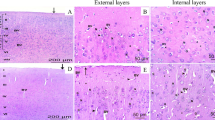Abstract
In this study, the effects of acute SO2 derivatives and chronic lead exposure together on sodium currents (INa) were investigated in acutely isolated rat hippocampal neurons by using the whole-cell patch clamp techniques. We found that chronic lead exposure hardly reduced the amplitudes of INa. In the normal condition, sodium current started to appear at around −70 mV, and reached the peak current at around −40 mV. After chronic lead exposure, the data changed to −70 and −30 mV. After adding SO2 derivatives, the data changed to −80 and −40 mV, respectively. SO2 derivatives caused a significant increase of INa in hippocampal chronic-lead exposed neurons. Chronic lead exposure induced a right shift of the activation curve and a left shift of the inactivation curve of sodium channels. SO2 derivatives caused negative shifts of the activation and inactivation curves of INa in hippocampal chronic-lead exposed neurons. Lead exposure put off the time reaching the peak of INa activation. SO2 derivatives increased the time constants of inactivation after lead exposure. The interaction of lead and SO2 derivatives with voltage-dependent sodium channels may lead to changes in electrical activity and contribute to worsening the neurotoxicological damage.
Similar content being viewed by others
References
Meng Z Q, Zhang B. Oxidation damage of sulfur dioxide inhalation on brains and livers of mice. Environ Toxicol Pharmacol, 2003, 13: 1–8, 10.1016/S1382-6689(02)00106-0
Nie A F, Meng Z Q. Study of the interaction of sulfur dioxide derivative with cardiac sodium channel. Biochim Biophys Acta, 2005, 1718: 67–73, 16298331, 10.1016/j.bbamem.2005.09.020, 1:CAS:528:DC%2BD2MXht1OltLjJ
Nie A F, Meng Z Q. Sulfur dioxide derivative modulation of potassium channels in rat ventricular myocytes. Arch Biochem Biophys, 2005, 442: 187–195, 16168948, 10.1016/j.abb.2005.08.004, 1:CAS:528:DC%2BD2MXhtFekurbM
Gu Y, Wang L, Xiao C, et al. Effects of lead on voltage-gated sodium channels in rat hippocampal CA1 neurons. Neuroscience, 2005, 133: 679–690, 15896915, 10.1016/j.neuroscience.2005.02.039, 1:CAS:528:DC%2BD2MXltFWisrc%3D
Dai X Q, Ruan D Y, Chen J T, et al. The effects of lead on transient outward currents of acutely dissociated rat dorsal root ganglia. Brain Res, 2001, 904: 327–340, 11406131, 10.1016/S0006-8993(01)02505-7, 1:CAS:528:DC%2BD3MXktlWmsrY%3D
Du Z Q, Meng Z Q. Effect of lead on transient outward K+ current and delayed rectifier K+ current of acutely dissociated rat hippocampal neurons. Chin J Appl Environ Biol, 2003, 9(6): 619–622, 1:CAS:528:DC%2BD2cXmtFejsLY%3D
Du Z Q, Meng Z Q. Inhibitory effect of lead on sodium currents in acutely isolated rat hippocampal neurons. Chin J Pharmacol Toxicol, 2004, 18(1): 62–65, 1:CAS:528:DC%2BD2MXivVKisLw%3D
Wang G L, Liu S J, Lu P, et al. Lipid peroxidation of myocardial microsome membrane in rats chronically poisoned with low levels of lead. J Hyg Res, 1996, 25(5): 265–267, 1:CAS:528:DyaK2sXktleqsL0%3D
Macek M D, Matte T D, Sinks T, et al. Blood lead concentrations in children and method of water fluoridation in the United States, 1988–1994. Environ Health Perspect, 2006, 114(1): 130–134, 16393670, 1:CAS:528:DC%2BD28XosVOitg%3D%3D
Zou B D, Chen Y Z, Wu C H, et al. Blockade of U50488H on sodium currents in acutely isolated mice hippocampal CA3 pyramidal neurons. Brain Res, 2000, 855(1): 132–136, 10650139, 10.1016/S0006-8993(99)02360-4, 1:CAS:528:DC%2BD3cXmtVOjtQ%3D%3D
Meng Z Q, Sang N. Effect of SO2 derivatives on sodium currents in acutely isolated rat hippocampal CA1 neurons. Acta Physiol, 2002, 54(3): 267–270, 1:CAS:528:DC%2BD3sXpvFKnurw%3D
Urenjak J, Obrenovitch T P. Pharmacological modulation of voltage-gated Na+ channels: A rational and effective strategy against ischemic brain damage. Pharmacol Rev, 1996, 48(1): 21–67, 8685246, 1:CAS:528:DyaK28XisFymt7Y%3D
Environmental Neurotoxicology/Committee on Neurotoxicology and Models for Assessing Risk. Commission on Life Sciences. Washington DC: National Research Council/National Academy Press, 1992
Antzelevitch C, Belardinelli L. The role of sodium channel current in modulating transmural dispersion of repolarization and arrhythmogenesis. J Cardiovasc Electrophysiol, 2006, 17(1): S79–S85, 16686686, 10.1111/j.1540-8167.2006.00388.x
Pfahnl A E, Viswanathan P C, Weiss R, et al. A sodium channel pore mutation causing Brugada syndrome. Heart Rhythm, 2007, 4(1): 46–53, 17198989, 10.1016/j.hrthm.2006.09.031
Barela A J, Waddy S P, Lickfett J G, et al. An epilepsy mutation in the sodium channel SCN1A that decreases channel excitability. J Neurosci, 2006, 26(10): 2714–2723., 16525050, 10.1523/JNEUROSCI.2977-05.2006, 1:CAS:528:DC%2BD28XislKrtb8%3D
Cestèle S, Qu Y, Rogers J C, et al. Voltage Sensor-Trapping: Enhanced activation of sodium channels by β-scorpion toxin bound to the S3–S4 loop in domain II. Neuron, 1998, 21: 919–931, 9808476, 10.1016/S0896-6273(00)80606-6
Yan D, Wang L, Ma F L, et al. Developmental exposure to lead causes inherent changes on voltage-gated sodium channels in rat hippocampal CA1 neurons. Neuroscience, 2008, 153(2): 436–445., 18367338, 10.1016/j.neuroscience.2008.02.016, 1:CAS:528:DC%2BD1cXls1yktrk%3D
Hu H J, Yang D M, Dai D Z, et al. Bepridil inhibition of sodium current in rat hippocampal CA1 neurons. Acta Pharmacol Sin, 1999, 20(9): 819–823, 1:STN:280:DC%2BD3M3ks1Whtg%3D%3D
Egdell R M, MacLeod K T. Calcium extrusion during after contractions in cardiac myocytes: The role of the sodium-calcium exchanger in the generation of the transient inward current. J Mol Cell Cardiol, 2000, 32: 85–93, 10652193, 10.1006/jmcc.1999.1056, 1:CAS:528:DC%2BD3cXnsVWjsw%3D%3D
Xue J, Zhou D, Yao H, et al. Role of transporters and ion channels in neuronal injury under hypoxia. Am J Physiol Regul Integr Comp Physiol. 2008, 294(2): 451–457
Reppel M, Fleischmann B K, Reuter H, et al. Regulation of Na+/Ca2+ exchange current in the normal and failing heart. Ann N Y Acad Sci, 2007, 1099: 361–372, 17446476, 10.1196/annals.1387.065, 1:CAS:528:DC%2BD2sXlt1Gks7w%3D
Graves S W. Sodium regulation, sodium pump function and sodium pump inhibitors in uncomplicated pregnancy and preeclampsia. Front Biosci, 2007, 12: 2438–2446, 17127253, 10.2741/2245, 1:CAS:528:DC%2BD28Xht1OnsbvK
Author information
Authors and Affiliations
Corresponding author
Additional information
Supported by the National Natural Science Foundation of China (Grant No. 20637010), and University of Science and Technology Foundation of Shanxi Province (Grant No. 200713010)
Rights and permissions
About this article
Cite this article
Du, Z., Lü, G. Effects of SO2 derivatives on sodium currents in acutely isolated rat hippocampal lead-exposed neurons. SCI CHINA SER C 51, 802–807 (2008). https://doi.org/10.1007/s11427-008-0098-5
Received:
Accepted:
Published:
Issue Date:
DOI: https://doi.org/10.1007/s11427-008-0098-5




